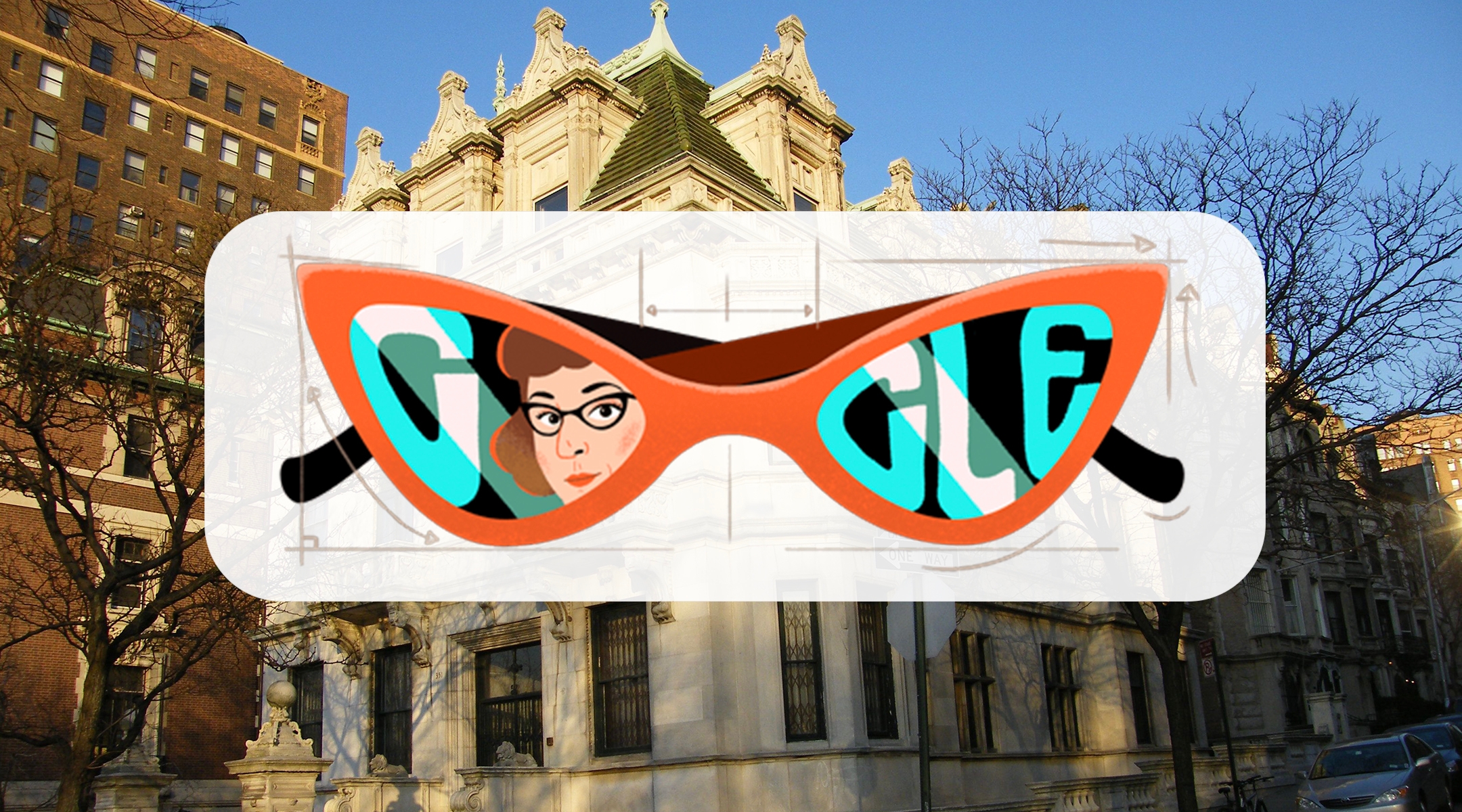(New York Jewish Week) – The Google Doodle for Friday, Aug. 4 features a cartoon image of a bespectacled woman peering out from one of the lenses of orange cat-eye glasses. The Doodle celebrates the 116th birthday of Altina “Tina” Schinasi, the Sephardic Jewish artist, inventor and New Yorker who devised the distinctive eyeglasses.
A trained sculptor, Schinasi designed the glasses in the late 1930s while working as a window display designer in Manhattan. Many major manufacturers rejected her designs, inspired by the Italian Harlequin mask, because they were too edgy. She pushed forward and partnered with a boutique optical shop called Lugene on Madison Avenue, where one of the first pairs was sold to writer Clare Boothe Luce. Schinasi’s designs took off and she soon established her own eyewear company.
The “Harlequin”-style glasses, more popularly known as “cat-eye,” became a hallmark of glamor in the late 1930s and were a dominant eyeglass silhouette through the mid-20th century, worn by the likes of Lucille Ball, Marilyn Monroe and Audrey Hepburn.
By the mid-1940s, Schinasi sold her eyeglasses company and moved out to Los Angeles, where she again focused on painting, sculpture and, later in life, filmmaking. Three of her paintings appeared in an exhibit at the Los Angeles County Museum of Art.
Schinasi was born on this day in 1907 at her family’s mansion at 351 Riverside Drive. She was the youngest of three daughters born into a wealthy Sephardic family. Her dad, Turkish-born Morris Schinasi, was an international tobacco businessman who made his fortune by inventing a cigarette-rolling machine and then selling his own brand of cigarettes.
Her mother, Laurette Schinasi, was born in Salonica (now Thessaloniki, Greece). The two met when Morris Schinasi was on a business trip to Salonica — Laurette was the granddaughter of his business partner. They married in 1903.
Upon Morris Schinasi’s death in 1928, the Jewish Telegraphic Agency reported that Schinasi left $1.3 million (roughly $23 million in today’s dollars) to be allocated to several hospitals and Jewish charities, as well as to erect a hospital in Turkey and a new synagogue building for the Bual Zion Congregation (now the B’nai Zion Congregation), a Conservative synagogue in Chattanooga, Tennessee.
The Schinasi Mansion was designed by William Tuthill, the same architect who constructed Carnegie Hall, in the early 1900s. It was declared a New York City Landmark in 1974 and was added to the National Register of Historic Places in 1980. Currently owned by Goldman Sachs executive Mark Schwartz, it still sits on West 107th Street and Riverside Drive and is presently the largest single-family residence along Riverside Drive.
As a child, Tina Schinasi attended the Horace Mann School in the Bronx before beginning boarding school at age 12 at Dana Hall School in Wellesley, Massachusetts. A biography of Schinasi in an online Dana Hall encyclopedia states that Schinasi felt that “although she had many friends, she often felt isolated as one of the only Jewish students on campus and tried to hide that part of her identity from her classmates.”
Upon graduating, Schinasi studied painting in Paris and decided to attend art school instead of college. In the late 1920s, she began to study painting with Samuel Halpert, a Russian Jewish immigrant, at the Nicholas Roerich Museum on the Upper West Side.
Schinasi’s first job was designing windows for stores on Fifth Avenue, where she brushed shoulders with the Spanish artist Salvador Dalí. She and Dalí then went on to study under George Grosz, who had fled Germany in 1932 and Maurice Sterne, a Jewish sculptor and painter from Latvia.
In the late 1930s, Schinasi had her artistic breakthrough and achieved a lasting legacy through her patented design of the Harlequin eyeframe. Per Wikipedia, “A walk down the street occasioned this design breakthrough; finding herself underwhelmed by the lackluster frames in an optician’s window, Altina set out to create a frame that conveyed whimsy, mystery and romance.”
Support the New York Jewish Week
Our nonprofit newsroom depends on readers like you. Make a donation now to support independent Jewish journalism in New York.
“‘Surely, there must be some way to design eyeglasses that could be attractive! What looks good on a face? What adds to a face? What could a woman wear on her face that would be romantic?’ she wondered.”
In 1939, she won the Lord & Taylor Annual American Design Award. She has been credited with transforming eyeglasses into a fashion accessory.
In 1960, she produced a documentary film about her former art teacher, the late Grosz, who, though not Jewish, was in exile from Germany and was active in anti-Nazi efforts. Titled “George Grosz’ Interregnum,” the 29-minute film was nominated for an Academy Award and won first place at the Venice Film Festival.
Also during the 1960s, Schinasi acquired the film rights for Martin Luther King Jr.’s March on Washington. She commissioned a screenplay and met with King, Rosa Parks and other leaders of the Civil Rights Movement while on a trip to Alabama. All expressed excitement about the movie. However, Schinasi could not raise funding for the film and it was never made.
Married four times, Schinasi had two children, Terry Sanders and Denis Sanders, with her first husband Morris Sanders. Both of her sons became film directors. In 2014, her grandson Peter Sanders and her granddaughter Victoria Sanders produced and directed “Altina,” a documentary about her life.
“My grandmother Tina was proud of her Jewishness, deeply affected by the rise of the Nazis and personally furnished 13 affidavits to enable Jewish refugees to enter the United States. But we were never practicing Jews in the religious sense,” Peter Sanders told JTA at the time. The film relied on footage shot on the honeymoon of her first marriage in 1927 and 1928, as well as a two-hour interview filmed by her son in 1991.
Altina Schinasi died in Santa Fe, New Mexico in 1999 at age 92.
In a note from Google, the company wrote, “Happy birthday to the woman who was a visionary in more ways than one!”
Google also thanked Schinasi’s son Terry Sanders for his contributions to the project. In a note, Sanders wrote, “Happy Birthday, Tina! Thank you for your courage, kindness and inspiration. Much love, always,” and signed it on behalf of himself and Schinasi’s seven grandchildren: Victoria, Juliette, Peter, David, Eve, Jessica and Brittany.





